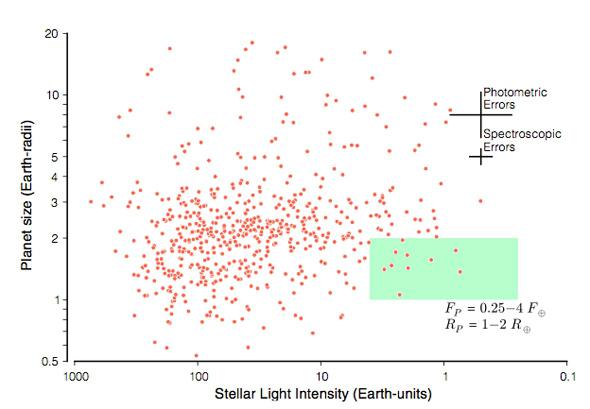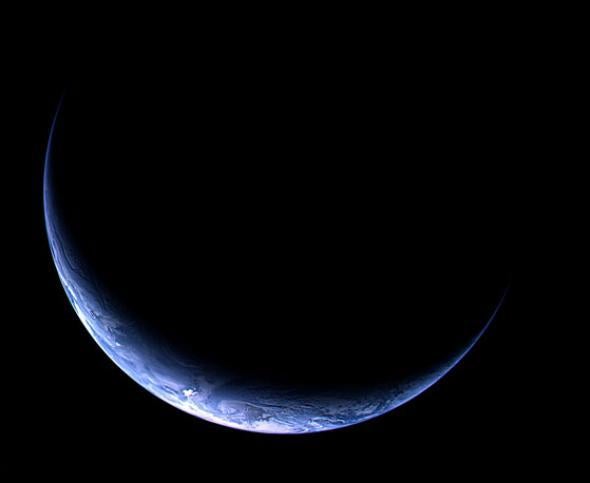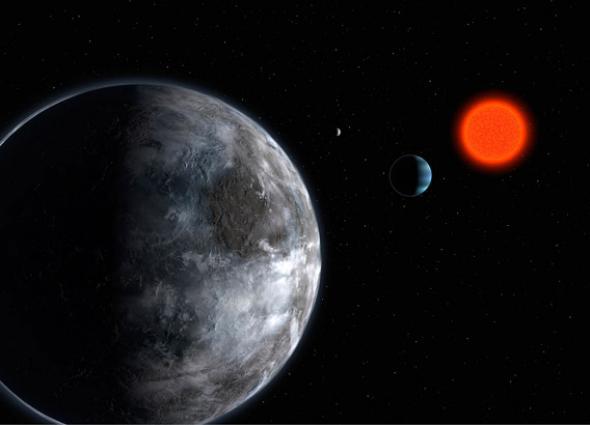One of the biggest questions in astronomy today is easy to ask, and incredibly hard to answer: How many Earth-like planets are there in the Universe?
By Earth-like, I mean planets roughly the size of Earth, and which are also roughly the same temperature as Earth. So we can ignore frigid iceballs far from their stars, boiling lava planets too close in, and giant and dinky planets. We want to know about potentially habitable planets, where life as we know it has a shot at getting a toe (or pseudopod) hold.
This question is hard to answer because such planets are faint and very hard to detect. However, a team of astronomers today has announced they have come to a startling conclusion: Roughly one in five Sun-like stars should have Earth-like planets orbiting them.
This conclusion takes a bit of explanation, and involves some caveats. Still, I think their number is robust, and in fact may underestimate the total number of Earth-like planets (once you include stars that aren’t just like our Sun).
Seeing the Light
The astronomers looked at data from the Kepler spacecraft, which observed more than 150,000 stars in a small patch of the sky. For four years it observed these stars every 30 minutes, looking for telltale dips in their brightnesses. The idea is that if a star has a planet (or planets), and we happen to see the orbit of this planet edge-on, then we’ll see a small drop in the star brightness every time the planet transits (passes directly in front of) the star.
And it works! Kepler has detected something like 3000 potential planets in the sample, about a third of which have been confirmed. As it happens, bigger planets are easier to detect because they block more starlight, making the dip easier to see (in fact, the size of the dip tells you the size of the planet, if you know how big the star is too). Also, planets close in to their stars are easier to find, because they orbit more quickly and you get more dips to observe as well. That’s why big (Jupiter-sized) planets on really short orbits were the first ones to be found. They’re really easy to spot.
But we’re biased, we humans. While life might take lots of different forms, we know that life on Earth needs liquid water. So we want to know how many planets are out there that have conditions similar to Earth’s: about the same gravity as Earth, a composition that’s metal and rock (and not a gas giant), and the right temperature for liquid water to exist. The temperature depends on how hot the star is, and how far the planet is from it. It also depends on lots of other things, like if the planet has a thick or thin atmosphere, and so on, but for now we can keep it more general.

Illustration by Petigura/UC Berkeley, Howard/UH-Manoa, Marcy/UC Berkeley.
The Spark of a Familiar World
To figure this out, the astronomers narrowed the search to look at only stars like the Sun, that is, stars with about the Sun’s size and temperature (for astro-nerds out there, spectral types G and K). They also wanted the stars to be bright enough to get good statistics. When they were done they were left with 42,557 stars in the Kepler sample — still quite a few.
They used some sophisticated software to examine the light from these stars, looking for possible planets. There are lots of spurious effects that can masquerade as planets (for example, binary stars that change brightness can make it look like a star has a planet when it may not). They also knew they wouldn’t catch every single planet; you always miss a few. So they added a known number of artificial planet signals into the data, to see how many the software caught (this is called testing the completeness of the software). They could then use this to help them understand how well the code did. It’s a bit like handicapping in golf, actually, to make sure everyone is on an even playing field.
When all was said and done, they found 603 planets in total. Some were big, some small, some on orbits very close to their star, others more far-flung. So how many were Earth-like?
They needed definition of “Earth-like” to do that. They decided to look only for planets 1 – 2 times the radius of Earth; even a bigger planet can have gravity similar to our home world, but if they get bigger than that it’s not as clear that conditions on the surface will be like ours.
The temperature of the planet is important, of course, and depends on how much light the planets gets from its star. As a range, they looked for planets that received no more than four times the light the Earth receives from the Sun, and no less than 0.25 times as much. That should bracket the warm and cool edges of the “habitable zone”, where water can exist. This range may in fact be much broader; a planet can be much farther from its star and still have liquid water (see Enceladus as an example), but they wanted to be conservative.
And what did they find? Out of 603 total planets, ten planets fit these criteria. In other words, they found ten planets that are potentially Earth-like.
At first that number may seem pretty low. Ten planets, out of more than 42,000 stars? Earth-like planets must be rare!

Plot by Petigura, Howard, and Marcy, from their journal paper
But you have to be careful. For example, we only see planets on orbits that take them directly between us and their stars; if we see their orbit face-on we won’t detect the planet. You have to take into account all the ways you might miss a planet, and then factor that in.
When they were done, they found that 22 percent of Sun-like stars have Earth-like planets.
That’s pretty amazing. The galaxy must be full of planets like ours! In fact, if you look at how many stars like this are nearby, you find that, statistically speaking, the nearest such Earth-like planet may be only 12 light years away! Again, that’s just what the odds are. Still, there are well over 100 Sun-like stars within 50 light years, so the chance of a few of them having Earth-like planets seems pretty high.
I’ll note that studies have been done before to figure out how many of these exoplanets are out there (like here and here), but what distinguishes this one are the parameters they used (size and incoming light) as well as the robustness of their software checks, letting them know how many planets in the data they may have missed. This should improve the accuracy of the findings substantially. And the number they find, happily, is in line with previous studies as well.
Dreams — and Reality — of Distant Earths
So how many Earth-like planets are actually out there?
Stars like the Sun make up roughly 10 percent of all stars. There are very roughly 200 billion stars in the Milky Way, so that gives us 20 billion stars. If one of every five has an Earth-like planet, that means there are about four billion Earth-like planets in our galaxy alone!
And mind you, that’s only for stars like the Sun. Cooler stars are far, far more common than the Sun, and it’s already been found that 15 percent of smaller, cooler, red dwarf stars have an Earth-sized planet at the right distance to have liquid water on their surfaces (and if you relax that definition a bit, allowing planets to be closer or farther and still have liquid water, the percentage jumps to nearly half). Also, it’s possible that giant planets like Jupiter could have giant moons as well — we see that here in our own solar system — which allows for even more habitable worlds.
Working the other way, as I mentioned above, this doesn’t account for different compositions, and more importantly different atmospheres of these worlds. The planet might be the right size and distance from its star, but have an atmosphere of carbon dioxide that gives it a runaway greenhouse effect, making it a blazing hell like Venus. Or it may have a thin atmosphere which can’t retain heat, making it a cold, desolate desert like Mars. Or it may have a lot of ammonia in the air, or some other noxious gas. We don’t know anything yet about such contingencies. But planets like this would still be counted as Earth-like in the study here, so we need to keep that in mind.

Photo by ESA ©2009 MPS for OSIRIS Team MPS/UPD/LAM/IAA/RSSD/INTA/UPM/DASP/IDA
Still, I find this hopeful. What this means is that from everything we can tell using our observations, knowledge of physics, and careful application of statistics, there could be tens of billions of Earth-like planets just in our galaxy alone.
If your head isn’t sufficiently reeling from that, then let me add: There are hundreds of billions of galaxies in the Universe. That gives us a billion trillion Earth-like planets in the Universe.
Now here’s a thing I want you to know: The first planet orbiting a star other than the Sun was discovered in 1991. The first planet orbiting a Sun-like star was found in 1995. We’ve been looking for longer than that, but still, we’ve only been finding planets for less than 20 years. We know of about 1000 for sure, and that’s in large part due to the efforts of the scientists and engineers who built and used the Kepler spacecraft.
And in the four short years that observatory operated, we now have enough information to estimate how many Earths may be lurking out there, somewhere in the deep dark.
We’re still a ways from detecting them directly; that is, getting an image of them. They are faint, and far away. And of course we’re even farther from actually visiting one; even if the astronomers are right and the nearest one is 12 light years away, that’s 120 trillion kilometers. It would take a probe centuries, millennia, to get that far, assuming no breakthrough in physics.
But those planets are out there, and our knowledge of them increases nearly every day. As that happens, our hunger to learn even more increases. NASA and other agencies have plans to build bigger and better observatories to seek out new planets, and get direct images of them. Studies like this one can help guide the design of such detectors, and give us an idea of how best to find even more such worlds.
When I was a lad, we knew of nine planets. Now we have thousands, and a good idea of how many of them may turn out to be similar to our own. It seems inevitable to me that the day will come when we can take the next step, and determine which of these have life. Given these numbers, and how easily life arose on Earth, it also seems inevitable that those planets exist. We just have to find them. That’s still a Herculean task, and will require vast effort, but one well worth undertaking.
